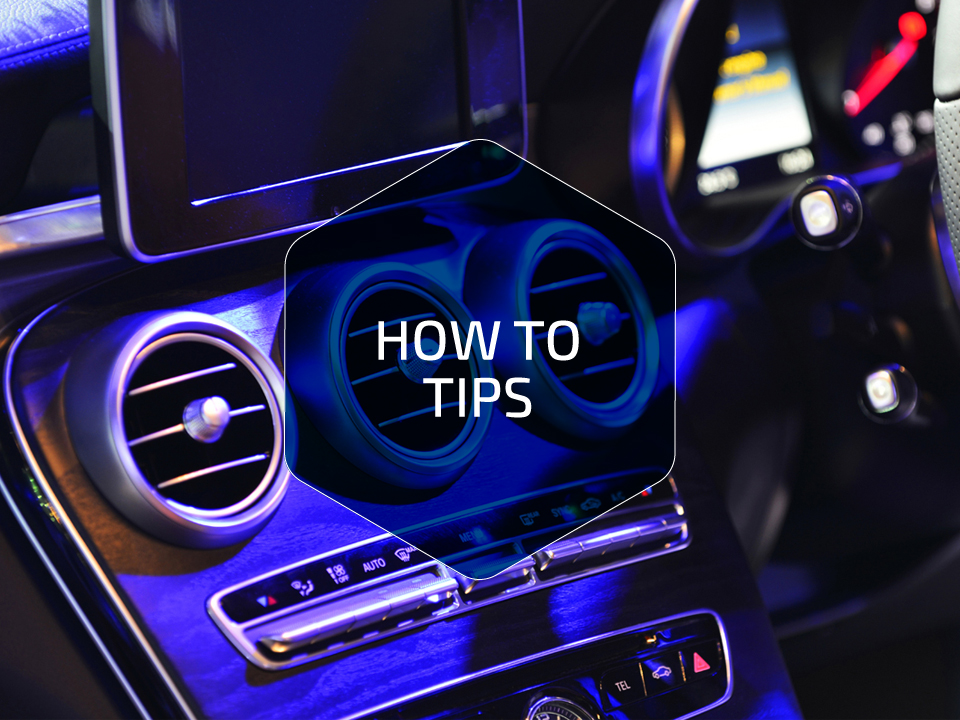
How To Tips
Your car can be a great place for music listening. Many commuters suffer for hours each day with inferior sound quality that they’d never tolerate from their systems at home. Others assemble sophisticated sound systems in their cars that don’t reach their full potential because of some common mistakes.
Here are some suggestions on how to improve the sound in your vehicle, with some tips for simple factory systems and some ideas for more sophisticated setups. Don’t live with bad sound — even the simplest improvements to your system can yield great results.
Tip No 1: Replace your car’s speakers.
In most cases, speakers are just about the last thing a manufacturer thinks about when building your car. Factory systems have improved in the last few years, but many so-called “premium” systems still use relatively inexpensive amps and speakers that don’t deliver top-notch sound. You can make a big difference in your system’s sound quality by installing a nice set of speakers. You’ll hear tighter bass and more overall clarity, and you’ll most likely notice little details in familiar songs that you’ve never caught before. Replacement speakers give you maximum bang for your buck, so they’re a good first step on the road to better sound.
Tip No 2: Select a lower level of compression for your music files.

Apple iPod® nano
Yes, you can store more music files in your MP3 player with more compression, and they’ll sound OK when you’re listening through earbuds. But you lose some high- and low-frequency information when you compress your music, along with some of the details that make your music interesting. And, on a good car audio system, you can really tell that something’s missing.
Don’t settle for the default setting when creating your files. If you want to use your iPod or MP3 player in your car, try using as little compression as possible. The higher the bit rate, the better your music will sound through your car’s system.
Tip No 3: Use Dynamat or another sound deadening material.
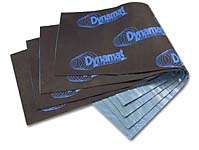
This Dynamat door kit will treat all four doors in your vehicle.
Dynamat does two things to make your system sound better. First, the thin metal in your door panel does not make a good home for a speaker — it vibrates as your speaker plays, affecting accuracy. When you attach Dynamat to your door panel, it deadens those vibrations and rattles, creating a more stable platform for your speaker, more like the wooden baffle on a home speaker.
Second, have you ever noticed how your system sounds really good at 25 mph, but gets a little harsh when you hit 60? Road noise tends to mask the lower frequencies first, so your system sounds overly bright when you turn it up at highway speeds. Dynamat lowers interior noise levels in your car, so you don’t have to turn your music up as loud when you’re driving. You’ll hear more musical detail, and your amps won’t have to work as hard. And that’s all good.
Tip No 4: Add an amplifier.
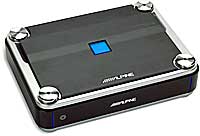
Alpine’s PDX-2.150 amplifier
You may be saying “My original stereo puts out 200 watts, and that’s plenty of power.” But there’s a huge difference between 50 watts peak power per channel produced by your car stereo and 50 watts RMS from an outboard amplifier. A separate amplifier will provide more clean power than any car stereo, and that’ll make a night-and-day difference in sound quality. Your system will sound better, whether you listen to Mahler at a conversational level or Coldplay turned up to 11. An amplifier is essential to getting great sound in your car.
Tip No 5: Add a signal processor or an equalizer.
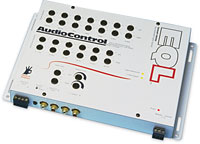
AudioControl’s EQL equalizer features 13 bands of equalization, and its level matching controls deliver maximum voltage to your amplifiers.
A car interior presents some serious problems when it comes to sound quality. Glass and plastic surfaces reflect sound like crazy, while carpet, seat covers, and other absorbent materials soak it up. Add poorly-placed speakers to the mix, and you’ll find significant peaks in frequency response in most car interiors. These peaks make your music boomy in the bass or shrill in the upper frequencies, causing “ear fatigue.”
Most car receivers give you treble, midrange, and bass controls — useful for global fixes but not for zeroing in on problem areas. You’ll need a sophisticated equalizer to kill these peaks, whether it’s built into your receiver or in a processor that you mount in your dash or near your amplifiers.
An outboard equalizer gives you multiple points for adjusting frequency response, so you can iron out the peaks in your system. A parametric equalizer allows you to vary the centerpoint and width of each EQ band, so you can really zero in on a problem area. Sound processors can help you eliminate frequency response peaks and increase bass response, and some even include a microphone for analyzing your car’s acoustics.
Tip No 6: Build a better sub box. Or buy one.
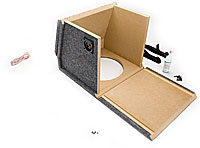
Q-Logic’s ready-to-assemble 10″ enclosure
If you’re building a sealed box, make sure it’s sealed properly. Air leaks can really hurt your sub’s performance. If you’re using a ported box, make sure you’ve got the right sub in there. You can destroy a sub that’s designed for sealed box use by driving it hard in a ported enclosure. Also, it’s important to build a box with the correct interior volume for the sub you’ve picked out. A mismatch can result in poor performance or a sub fatality.
You can also avoid all of these issues by buying a premade or ready-to-assemble enclosure that’ll work with your subwoofer.
Tip No 7: Your crossover can really improve the sound of your system.
Many car CD tuners now include frequency filters that’ll work with your preamp and speaker outputs. If you’ve got a sub, use the high-pass filter to remove the low bass from your car’s full-range speakers. You’ll get more clean volume out of them, particularly if you’re driving them with the receiver’s built-in power. Or maybe your sub sounds really strong, but the bass sounds like it’s coming from behind you. Experiment with raising or lowering the crossover point on your low-pass filter, and you’ll be able to bring the bass up forward with the rest of the music.

This JL Audio Slash v2 Series amplifier features front and rear frequency filters.
Many amplifiers feature subsonic filters that remove super-low bass below the range of human hearing. Go ahead and turn it on — your amp and sub will run cleaner without that subsonic sludge. Also, the compression you use to create your music files can cause a low-frequency sputtering sound in your subs. Your subsonic filter can remove or minimize this noise.
Tip No 8: Set your amp gains properly.
Most people think the gain control on their new amplifier controls the volume level. Naturally, they turn it all the way up and then bad things happen. The gain control actually adjusts the amount of input signal coming into the amplifier. Crank it up too high, you’ll hear some nasty distortion.
The general idea is to turn your receiver’s volume control roughly 3/4 of the way up to maximum volume, then turn up your amp gain until you hear distortion. Back it off a little, and you’re all set. Every amp manufacturer will have specific suggestions, so you’ll want to check out your manual for the best way to set the gain on your new amplifier.
Tip No 9: Don’t max out your tone controls.
Boosting your original radio’s tone controls up to max might make your system sound better sitting in your drive, but it just creates distortion when you turn it up on the road. A heavy low-frequency boost, in particular, will put a big strain on your original system. If you want to fatten up your sound, try using a smaller boost in the bass, lower the highs and mids a touch, and then turn up your overall level a little more.
But maybe you’ve replaced your original radio with an aftermarket stereo that features a multi-band equalizer. The rule still holds true — you should avoid excessive tone boosts or cuts if possible. A bad EQ setting can make a good system sound terrible, while an intelligent tone curve can make a good system sound great.
Tip No 10: Add a sub and hear what you’ve been missing.

JL Audio ProWedge™ enclosure
A good subwoofer will bring the bottom octave of your music back into proper balance, so you’ll hear familiar tunes in a whole new light. It’ll take a load off your full-range speakers too, since you’ll be playing your tunes with the bass control set at “0” instead of “+5”.
Some people get turned off by subs thumping next to them at traffic lights, but it’s not just about the boom — you can adjust any subwoofer to fit your tastes and your vehicle. And once you drive with a subwoofer, you can never go back to living without one. Or two.
Tip No 11: Use a capacitor if you’re going to push your subs hard.

This StreetWires Power Station capacitor acts as a buffer between your bass setup and your car’s electrical system.
They didn’t have subwoofers in mind when they built your vehicle. Big bass sucks up a lot of power, and most car electrical systems aren’t equipped to deal with it. A capacitor acts as a buffer between your amps and your car’s battery. You connect the cap inline on the power cable from your battery, as close to the amp location as possible. It stores up power from your battery, then releases it instantly to satisfy your amp’s demand for the power needed to reproduce a big bass hit.
Maybe you notice a big drop in performance after you run your subs loud for a minute or two? Or do you see your headlights dimming in time to the music at night? A cap cures these problems by taking the brunt of those demand peaks from your amp, so your amp sees a more consistent supply of power.
Tip No 12: Use high-quality cables for your amplifiers.

These StreetWires ZeroNoise® 9 Series patch cables offer excellent signal transfer with minimal noise.
Electricity’s like running water. You wouldn’t run a garden hose from your well to your house, because not enough water would get through to keep up with demand. That’s why you don’t want to use cheap, undersized power cable to get power to your amplifiers — the amp will be starved for power when you start pushing up the volume control. Good power cable allows current to flow freely so your amp gets the juice it needs during peak demand.
High-quality patch cables promote better signal flow from your receiver to your amps, so you hear a more focused, detailed sound. And good patch cables will also reject noise caused by your car’s electrical system. Don’t believe it? Ask any guitar player about the importance of good cables.
